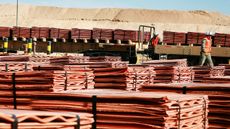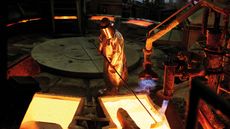I’ve never tipped a gold miner - until now
Relations between miners and local communities in Peru have often been fraught, says James McKeigue. But this Aim-listed miner has put that right.

For centuries, tales of Peruvian gold have enticed European investors. In the 16th century, reports of the wealth in the then Inca Empire lured Spanish conquistador Francisco Pizarro to what is now modern-day Peru.
His first two attempts failed, but eventually the persistent Pizarro managed to establish a toehold in the country. Like modern-day international investors, Pizarro was keen to profit from the country's natural resources albeit through slightly different means.
First, he captured the Inca emperor, Atahualpa, and demanded a roomful of gold as a ransom. Then, once he had received the gold, he killed the emperor anyway the first of many treacherous deals that would make local people wary of foreigners that come to exploit the country's natural resources.
Subscribe to MoneyWeek
Subscribe to MoneyWeek today and get your first six magazine issues absolutely FREE

Sign up to Money Morning
Don't miss the latest investment and personal finances news, market analysis, plus money-saving tips with our free twice-daily newsletter
Don't miss the latest investment and personal finances news, market analysis, plus money-saving tips with our free twice-daily newsletter
In the centuries following Pizarro's arrival, Europeans would develop different ways to exploit Peru's gold. When the indigenous mineworkers were almost wiped out by European diseases, the Spanish brought in slaves from Africa and following that, from China.
In the 19th century, slavery was abolished in Peru, yet working conditions and pay meant that life for many miners was not far off it.
In short, the post-Inca history of Peruvian mining is one of exploitation. A story where the foreigners, their descendents or international companies pushed the unwilling local population to unlock the country's incredible mineral reserves.
Nowadays, a lot of that has changed. Working conditions and pay in legal mines are good, making it a sought-after job. Yet, the history of opposition between international bosses and local workers and communities remains.
After all, Peru's mining projects take place in the poorest, most remote parts of the country; places where the community's memory of the 500-years of oppression haven't yet been replaced by the fruits of the country's two-decade-old economic boom.
Local communities are sick of broken promises
As I mentioned the other week, the reasons for these protests are complex. Sometimes they are because of genuine environmental concerns. Sometimes they are being propelled by the shadowy forces of illegal miners, drug lords and contraband smugglers.
But sometimes they are because the mining company has not got the approval of the local community. It's that last factor that I want to talk about today. Because I've found a London-listed miner whose good relations with the local community should help it develop a transformative new project.
Getting on with the local community can make the difference between a successful project and a failed one. Peru's president Ollanta Humala came to power on the promise that he would share the spoils of the country's economic boom with its rural majority. So far that hasn't happened.
Lots of complicating factors, such as inefficient or corrupt local authorities, have impeded Humala's attempts to boost investment in remote areas. As a result the rural communities feel betrayed and are determined to stop projects that they feel are violating their rights.
At times the protests, which involve thousands of people, have got so bad that Humala has declared martial law to take the extraordinary measures needed to quell them.
The one miner that Peruvians trust
Diego Benavides founded Minera IRL (Aim: MIRL) in 2000. Together with his Australian partner, Courtney Chamberlain, they sorted through a range of projects before securing exploration rights to a "small, but exciting" 140,000-ounce gold deposit high in the Peruvian Andes.
By 2007, they had a bankable feasibility study and tapped British capital by listing it on Aim. In the last decade, they've taken the mine from planning to production and churned out hundreds of thousands of ounces of gold.
Buoyed by their success, the pair led the firm on an ambitious expansion plan. They spent $11m on a fellow Aim-listed gold miner, which gave them the rights to a 360,000-ounce gold deposit in Argentina and a further 260,000 hectares of exploration rights. They also and this is the bit that interests me bought the rights to a one million-ounce gold deposit in the south of Peru.
All of this expansion, coupled with a slide in gold prices in the last year, seems to have worried investors with Minera's share price tanking by around 90% since its April 2011 peak. But I think that could be about to change.
The key to the transformation will be the Ollachea project in Peru. If everything goes to plan, the company is due to get financing and construction permits this summer and then produce its first gold in 2016.
Why am I optimistic? Well, for starters, the project looks likely to get financing. A lot of gold investors have been put off by the yellow metal's slide, but with it currently trading at $1,250 an ounce, Minera's estimated production cost of less than $600 per ounce looks pretty safe.
I also fancy construction to go without a hitch. After all, this same management team have a good track record. But the real reason for my optimism is the community relations.
As I've said before, I'm normally pretty sceptical about companies' corporate social responsibility blurb. But we've seen that in Peru it can make all the difference. And after having a long chat with Diego Benavides, I am pretty convinced that Minera's flagship project shouldn't have too many problems.
Minera's solution: Make the locals shareholders
Permission was eventually given after Minera agreed to launch all sorts of health and education programmes. Then, once a feasibility study had confirmed that there was a giant mining project to be had, Minera approached the community to negotiate another contract.
This 30-year contract had another slew of programmes, but the truly radical part was that it gave the community a 5% shareholding in the subsidiary that will operate the project. The only catch was that the community only gets its shareholding once the mine starts production.
"Now they can't wait for us to begin work soon enough", enthuses Diego Benavides. "While other communities are trying to stop projects, this community wants us to go even quicker."
In fact, he continues, the only ones not happy with the deal were the other mining companies. "Some of them were angry. They felt that by doing this, I was undermining them in future negotiations with communities."
Of course, buying shares in any miner that's about to launch its flagship project is always risky. And as Minera's own share chart proves investors can be an unforgiving bunch if they think a company is not performing. But to make the really big gains, you have to take risks.
In more than four years at MoneyWeek, I've never tipped a gold miner. But I think that Minera IRL's sound understanding of the complexities of the Peruvian mining scene make it a great way to get exposure to the country's legendary riches.
James graduated from Keele University with a BA (Hons) in English literature and history, and has a NCTJ certificate in journalism.
After working as a freelance journalist in various Latin American countries, and a spell at ITV, James wrote for Television Business International and covered the European equity markets for the Forbes.com London bureau.
James has travelled extensively in emerging markets, reporting for international energy magazines such as Oil and Gas Investor, and institutional publications such as the Commonwealth Business Environment Report.
He is currently the managing editor of LatAm INVESTOR, the UK's only Latin American finance magazine.
-
 Adidas, Nike or Jordans - could collectable trainers make you rich?
Adidas, Nike or Jordans - could collectable trainers make you rich?The right pair of trainers can fetch six figures. Here's how you can start collecting vintage Adidas, Nike or Jordans now
By Chris Carter Published
-
 Early bird ISA investors flock to global funds, India and the US
Early bird ISA investors flock to global funds, India and the USThere’s been an increase in investors maxing out their ISA at the start of the new tax year. But where are they putting their cash and why does it make sense to be an early bird investor?
By Vaishali Varu Published
-
 These 2 stocks are set to soar
These 2 stocks are set to soarTips The returns from these two aluminium and tin stocks could be spectacular when the commodity cycle turns says David J Stevenson.
By David J Stevenson Published
-
 A lesson for investors from a ill-fated silver mine
A lesson for investors from a ill-fated silver mineAnalysis Mining methods may have changed since the industry’s early days, but the business hasn’t – digging ore from the ground and selling it at a profit. The trouble is, says Dominic Frisby, the scams haven't changed either.
By Dominic Frisby Published
-
 The natural resources industry is in a tight spot – which is bad news for the rest of us
The natural resources industry is in a tight spot – which is bad news for the rest of usOpinion The natural resources industry is in a bind. We need it to produce more energy and metals, but it has been starved of investment, plagued by supply chain issues, and hobbled by red tape. That’s bad news for everyone, says Dominic Frisby.
By Dominic Frisby Published
-
 How to invest in the copper boom
How to invest in the copper boomTips The price of copper has slipped recently. But that’s temporary – the long-term outlook is very bullish, says Dominic Frisby. Here, he explains the best ways to invest in copper.
By Dominic Frisby Published
-
 Why investors should consider adding Glencore to their portfolios
Why investors should consider adding Glencore to their portfoliosTips Commodities giant Glencore is well placed to capitalise on rising commodity prices and supply chain disruption, says Rupert Hargreaves. Here’s why you should consider buying Glencore shares.
By Rupert Hargreaves Published
-
 How to invest in the multi-decade boom in industrial metals
How to invest in the multi-decade boom in industrial metalsTips The price of key industrial metals has already begun to rise. The renewable energy transition will take them higher, says David Stevenson. Here's how to profit.
By David Stevenson Published
-
 Avoid China’s stockmarket – here’s what to invest in instead
Avoid China’s stockmarket – here’s what to invest in insteadOpinion China’s stockmarket is not a good place for investors to be. But you can't just ignore the world's second-largest economy, says Dominic Frisby. Here, he picks an alternative China play.
By Dominic Frisby Published
-
 6 gold funds to buy to add exposure to the yellow metal
6 gold funds to buy to add exposure to the yellow metalGold Gold funds are one of the best ways of adding gold to your portfolio. We pick some of the best gold and gold-mining funds.
By Rupert Hargreaves Last updated